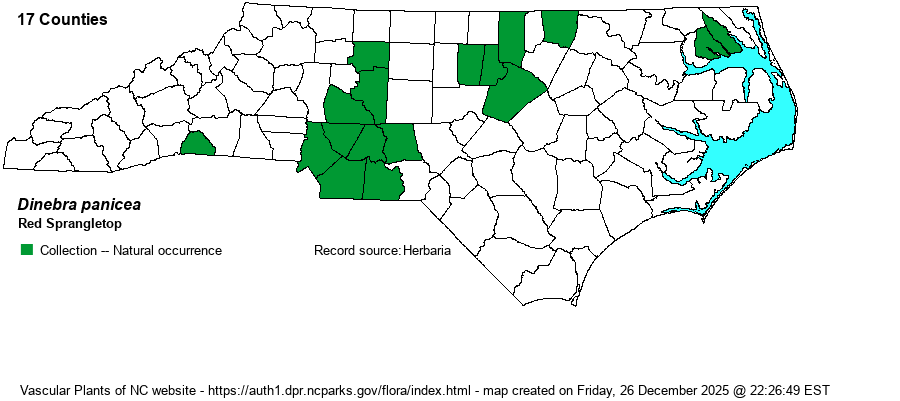| Author | (Retzius) P.M. Peterson & N. Snow | |
| Distribution | Mostly the middle and lower Piedmont; scarce in the northern outer Coastal Plain and in Polk County (southwestern Piedmont). Though Weakley (2018) considers it as native in NC, the Digital Atlas of the Virginia Flora website considers it as non-native in that state.
Cosmopolitan; in N.A.-- VA to KS and NV, south to FL, TX, and CA. | |
| Abundance | Uncommon in the central and eastern Piedmont, but quite rare elsewhere. Seemingly absent in the Mountains and most of the Coastal Plain. | |
| Habitat | Crop fields, old fields, gardens, clearcut bottomlands, disturbed areas, the soils mostly mesic. | |
| Phenology | Flowering and fruiting June-October. | |
| Identification | Red Sprangletop grows 1-3.5 feet tall, with a long inflorescence (to 1 foot) of many, alternate or sub-opposite, spreading branches. The spikelets are numerous and only 2-4 mm long, each with 2-5 florets. The lemmas are red-purple. It resembles members of the genus Diplachne, but their florets have awns (vs. none in Dinebra). | |
| Taxonomic Comments | In many texts treated as Leptochloa filiformis. Weakley (2018) considers the subspecies brachiata as occurring in NC.
| |
| Other Common Name(s) | Mucronate Sprangletop | |
| State Rank | S3 | |
| Global Rank | G5 | |
| State Status | | |
| US Status | | |
| USACE-agcp | FACW link |
| USACE-emp | FACW link |

